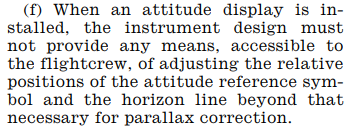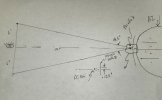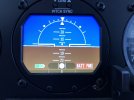Having it calibrated to an arbitrary configuration in level flight is pointless. That pitch attitude will only be level flight for one configuration. Teaching students to pitch to the horizon for level flight is a good way to have them descend into the ground when they are stressed out in IMC trying to shoot an approach without their cfi looking over their shoulder. If teaching proper attitude flying technique there is zero need for the attitude indicator to be calibrated to anything other than the actual axis of the airplane.
The hubris on display here has been very entertaining.
If I’m reading all of these posts correctly, your position is that the better way to teach beginning IFR students is by not confusing them and having the attitude indicator be perfectly level in level flight matching the horizon. This makes initial instrument training more intuitive for the pilot, however, they still would have to learn to interpret the instruments differently later on once presented with different attitude indicators that may not be level in-flight or different aircraft that may require different pitch attitudes for different CG conditions. I disagree with this learning strategy, but to each their own. There is the law of Primacy. Personally, I think learning very early in the process that you have to correlate your attitude presentation with your vertical speed backing this up is better than learning initially to be primarily dependent on the attitude indicator. But, I’m not a CFII, nor do instruct beginning instrument students. This is just my own personal learning experience.
I did find Ryan‘s comment about comparing the difference in the Borescope versus the flight path indicator as a pseudo-AOA reference to be interesting. I may turn my synthetic vision back on in my aspen, and start looking at this as a way of comparing AOA in different flight regimes.
You have to love the POA thread drift and vitriol, however
Both of your comments are ridiculous.... sorry no offense.
Tarheelpilot: Nothing is arbitrary. No one is flying into the ground. That kind of hyperbole really peeves me off. Send me a PM so I can tell you what I think of your ignorant comment.
Tokirbymd: There is no confusion and your reading comprehension is low if that is what you got out of the thread. Try it again from the top. As a CFI, ATP +33 years, 40 different aircraft J3 to B767, +1000 dual given GA, more at airlines, over +14k hours PIC, I understand the art Attitude Instrument Flying and how to teach. Thanks you. Your comment:
interpret the instruments differently later on once presented with different attitude indicators that may not be level n-flight or different aircraft that may require different pitch attitudes for different CG conditions
No kidding. They are PVT pilots with 60 total hours in a C152 IFR trainer... your point is moot. We established speed/power, weight, air density/altitude, configuration, flight maneuver, affects pitch. How #$*%^ obvious. IRRELEVENT to calibration installation of the G5 which was really bad, due to vague generic instructions more suited for other aircraft.
"Primacy" (first learned best learned) has nothing to do with it. Every airplane is a transition or different. The trainer is the trainer. The Simulator is the simulator. Another plane is different. If you have good instrument scan it does not matter... All my students will be proficient, precise, competent flying by sole reference to instruments, with skills and knowledge to transition to other planes nicely. I've been to the Rodeo before, dozens of students successfully passing their checkrides, all first time. A badly calibrated PFD is something I do NOT want my students to get use to in a C152. What if they fly a steam gauge GA plane with adjustable pitch Reference. OH NO!!!! I fly 3 degrees nose up in a B767 on final approach (descent)... I kind of get it. This is not my first day on the job.
There is the law of Primacy. Personally, I think learning very early in the process that you have to correlate your attitude presentation with your vertal speed backing this up is better than learning initially to be primarily dependent on the attitude indicator. But, I’m not a CFII, nor do instruct beginning instrument students. This is just my own personal learning experience.
This is BASIC Attitude instrument flying, SCAN, CROSS CHECK, INTERPRET. and CONTROL... Yes VSI is in the scan.... No kidding. You are the 5th or 20th person to say VSI. The AI/PDF is PRIMARY. Repeat PRIMARY and others are performance or monitoring. Calibrating the G5 to read something reasonable in cruise flight and cruise speed descents, is safe, legal and works well.
Both of you, this has been gone over +10 times. Both of you ignored the thread and are repeating the same obvious & irrelevant things others said ad nauseum. The reason and why I had maintenance calibrate the G5, why it is normal, OK, not a big deal, Garmin approved, STC approved, is settled. Not repeating myself... I get $60 hrs for dual and $203 hr to fly a jet. I take PayPal and Venmo if you like more instruction. G5 is now properly calibrated, and I am happy, students are doing great. Do as you like.




